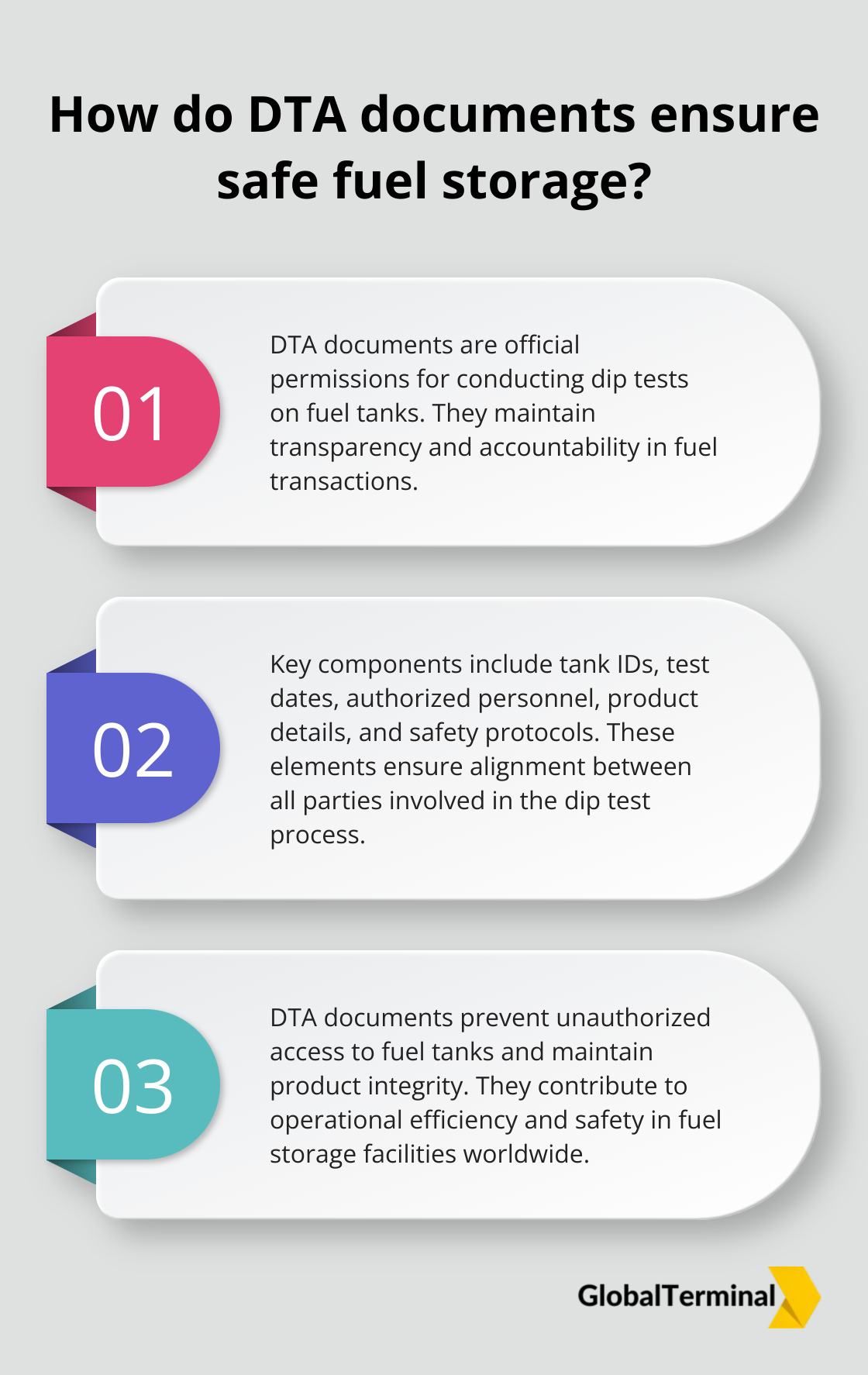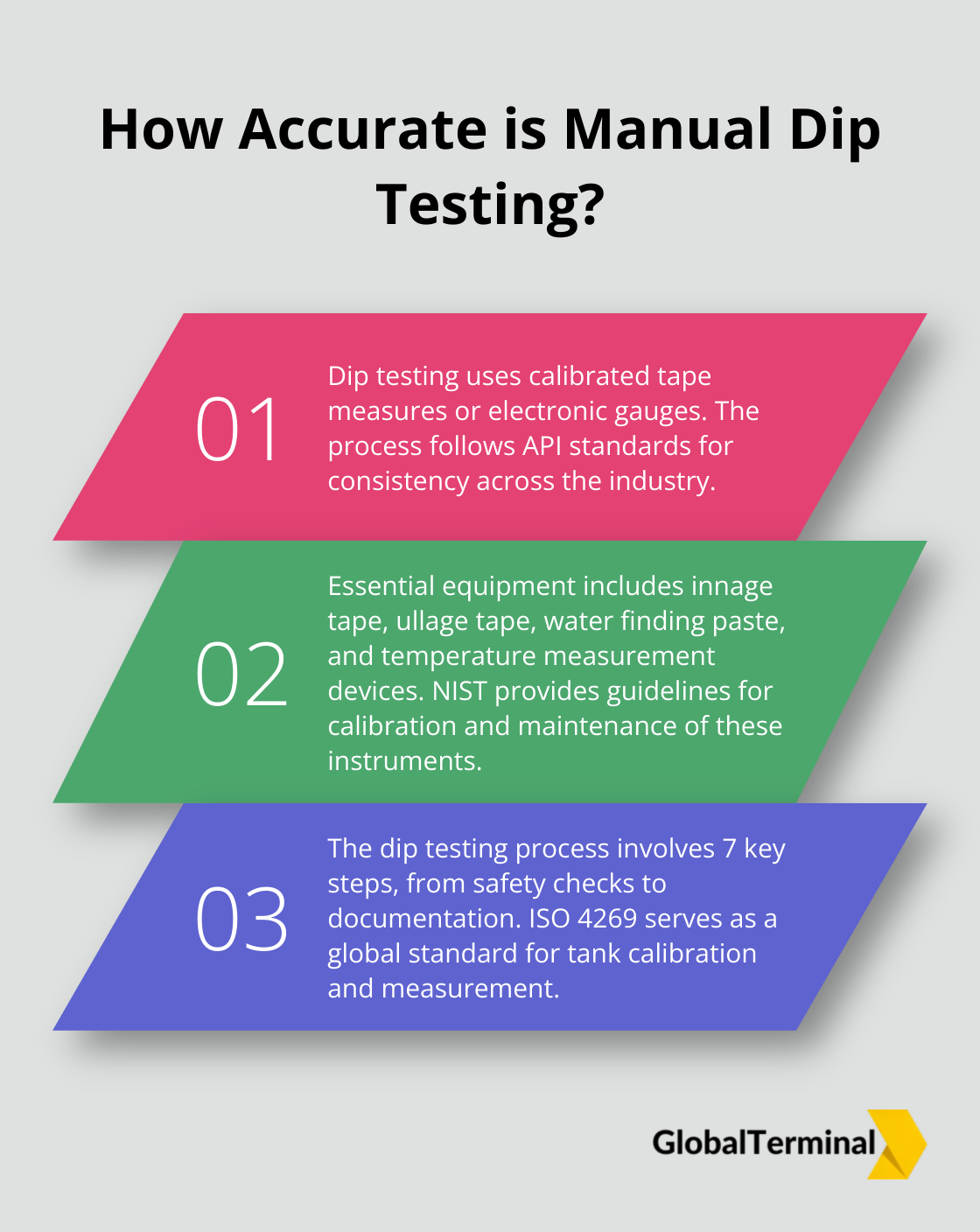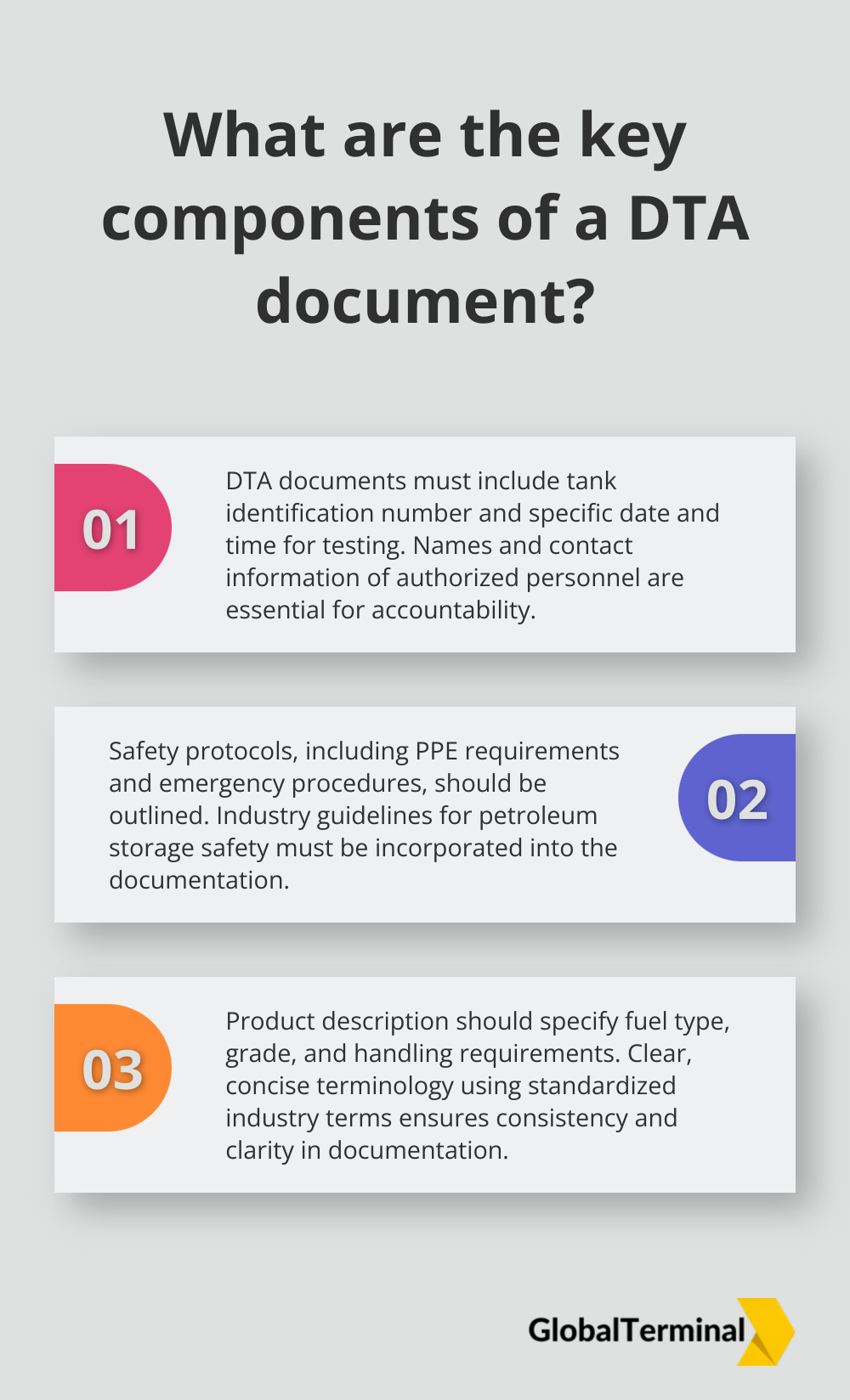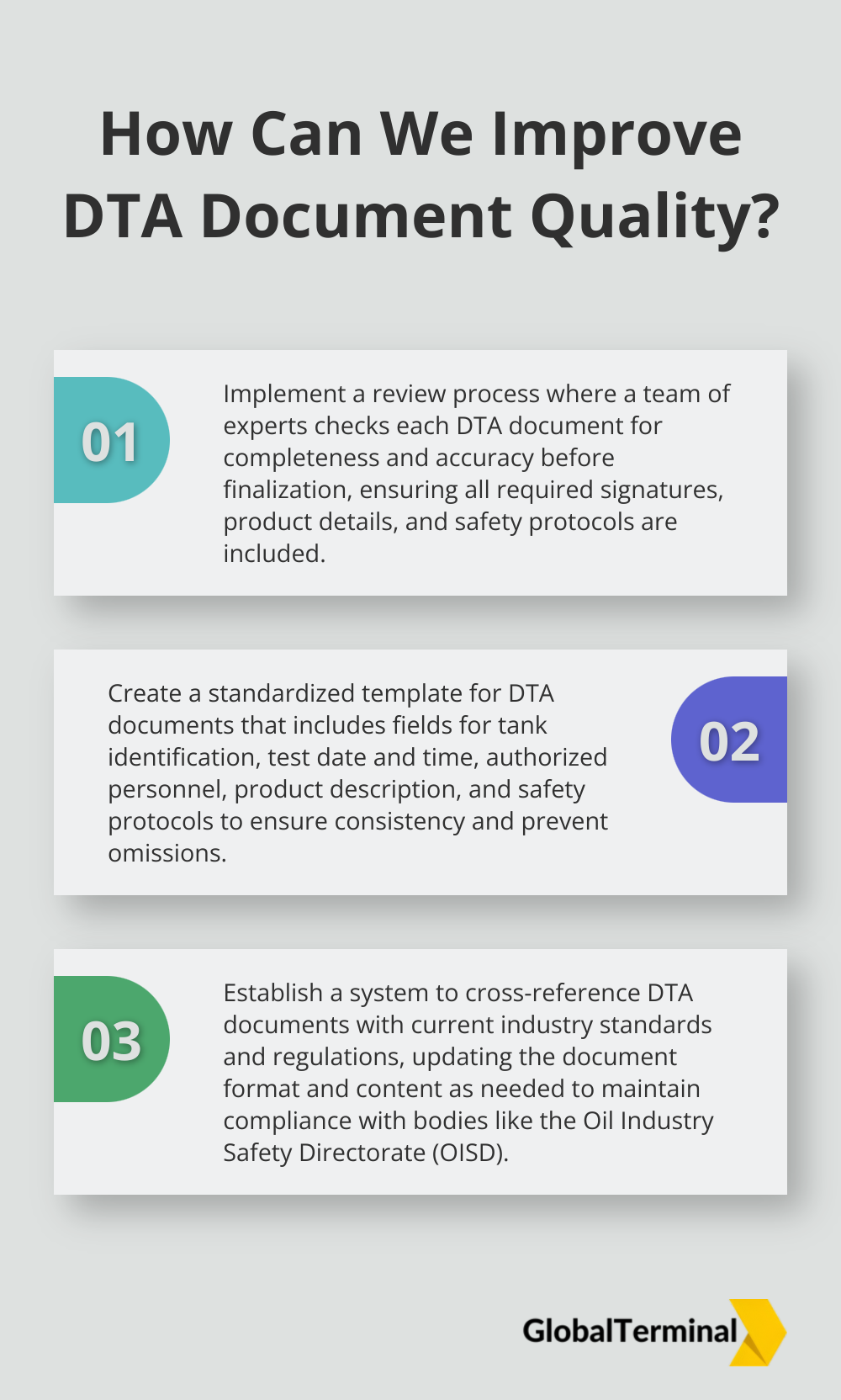
DTA Document for Dip Test
At GLOBAL TERMINAL NETHERLANDS B.V, we understand the critical role of accurate documentation in fuel storage operations. Dip Test Authorization (DTA) documents are essential for maintaining safety and efficiency in our industry.
This blog post will guide you through the intricacies of DTA documents for dip tests, explaining their purpose, components, and proper preparation techniques. We’ll also cover the essentials of dip testing and provide best practices for maintaining accurate records.
What Are DTA Documents?
Definition and Purpose
DTA documents (Dip Test Authorization documents) serve as official permissions for conducting dip tests on specified tanks. These documents ensure proper verification of fuel quantity and quality in the fuel storage and logistics industry.

DTA documents maintain transparency and accountability in fuel transactions. They provide a clear record of authorization, specifying who can perform the dip test, when it can occur, and under what conditions. This level of documentation prevents unauthorized access to fuel tanks and maintains the integrity of stored products.
Key Components
A well-crafted DTA document includes several essential elements:
- Tank identification numbers
- Specific date and time frame for the authorized dip test
- Names and contact information of authorized personnel
- Detailed description of the product to be tested
- Safety protocols to follow during the test
- Signatures of all relevant parties (including the tank farm operator)
These components ensure that all parties involved in the dip test process align, which reduces the risk of miscommunication or disputes.
Importance in Fuel Storage Operations
DTA documents play a vital role in fuel storage and logistics. They act as a cornerstone for maintaining operational efficiency and safety. By clearly defining the parameters of dip tests, these documents help prevent unauthorized access to fuel tanks, which reduces the risk of contamination or theft.
DTA documents also contribute to the overall safety of fuel storage facilities. They ensure that only qualified personnel conduct dip tests, following established safety protocols. This becomes particularly important in environments where flammable materials are present.
In logistics, DTA documents facilitate smooth transactions between buyers and sellers. They provide a standardized method for verifying fuel quantity and quality, which is essential for fair trade practices. A 2023 report by the World Trade Organization presented key data and trends for international merchandise and commercial services trade in 2023.
The significance of properly executed DTA documents extends to major fuel storage facilities worldwide. Strict protocols regarding DTA usage ensure the highest standards of safety and efficiency in fuel storage operations across global ports (such as Rotterdam, Houston, Singapore, Fujairah, and Antwerp).
As we move forward, let’s explore the essentials of dip testing and how it relates to these critical DTA documents.
How Dip Testing Works
The Dip Testing Process
Dip testing measures the level and quality of fuel in storage tanks. This process uses specialized equipment such as calibrated tape measures or electronic gauges. Operators lower these tools into the tank through a designated opening, allowing for precise measurement of the fuel level.

The American Petroleum Institute (API) standards guide the dip testing process, ensuring consistency across the industry. The API provides guidance on the installation, calibration, and verification of automatic tank gauging systems.
Essential Equipment for Dip Testing
Accurate dip testing relies on specialized equipment. Key tools include:
- Innage Tape: A graduated steel tape with a brass weight at the end, used to measure the depth of liquid in a tank.
- Ullage Tape: Similar to an innage tape but used to measure the empty space above the liquid.
- Water Finding Paste: Applied to the tape to detect the presence of water at the bottom of the tank.
- Temperature Measurement Devices: Thermometers or electronic temperature sensors to record the fuel temperature.
The National Institute of Standards and Technology (NIST) provides guidelines for the calibration and use of these instruments. NIST emphasizes the importance of regular maintenance and calibration to ensure accuracy.
Steps to Conduct a Dip Test
The dip testing process follows a structured approach:
- Safety First: Operators must ensure all safety protocols are in place before beginning. This includes wearing appropriate personal protective equipment and checking for any potential hazards.
- Preparation: Clean and inspect all equipment. Apply water finding paste to the lower part of the tape if water detection is required.
- Measurement: Slowly lower the tape into the tank until it touches the bottom. Wait for a few seconds to allow the tape to settle, then retrieve it carefully.
- Reading: Take the reading at the point where the liquid level meets the tape. If using water finding paste, note any color change indicating water presence.
- Temperature Recording: Measure and record the fuel temperature at different levels within the tank.
- Calculations: Convert the measured height to volume using tank calibration charts. Apply temperature corrections if necessary.
- Documentation: Record all measurements, including date, time, tank number, product type, and any observations.
The International Organization for Standardization (ISO) provides comprehensive guidelines for tank calibration and measurement in ISO 4269, which serves as a global standard for the industry.
Dip testing (when performed correctly) offers a reliable method for verifying fuel quantity and quality. Industry leaders like Global Terminal Netherlands B.V. adhere to these best practices, ensuring clients receive accurate and dependable fuel storage services across their global network of terminals.
As we move forward, we will explore the creation of DTA documents for dip tests, a critical step in maintaining the integrity and efficiency of fuel storage operations.
How to Create an Effective DTA Document
Essential Information for DTA Documents
A comprehensive Dip Test Authorization (DTA) document must include specific details to facilitate proper dip testing. The tank identification number should be prominently displayed, allowing for quick and accurate location of the tank in question. The document must specify the exact date and time frame for the authorized dip test. This temporal information prevents unauthorized access and ensures that all relevant parties are aware of the scheduled testing.

The names and contact information of authorized personnel are essential components of a DTA document. This information should include not only the individuals conducting the test but also key contacts at the storage facility. Clear identification of responsible parties maintains accountability in fuel measurement processes.
Documenting Safety Protocols
Safety takes precedence in dip testing operations. The DTA document should outline specific safety protocols to be followed during the test. These protocols might include requirements for personal protective equipment, procedures for handling potentially hazardous materials, and emergency response plans. Industry guidelines for safety in petroleum storage and handling should be incorporated into DTA documentation.
Avoiding Common Errors
One frequent mistake in DTA preparation is the omission of necessary signatures. All relevant parties, including the tank farm operator, must sign the document to validate the authorization. Standards for petroleum measurement emphasize the importance of proper authorization.
Another common error is insufficient detail in product description. The DTA should clearly specify the type of fuel being tested, its grade, and any special handling requirements. This level of detail prevents confusion and ensures that the correct testing procedures are applied.
Vague or imprecise language in DTA documents can lead to misinterpretation. Use clear, concise terminology that leaves no room for ambiguity. Try to use standardized industry terms to ensure consistency and clarity in fuel measurement documentation.
Quality Control Measures
Implementation of rigorous quality control measures prevents common errors in DTA document preparation. A team of experts should review each DTA document to ensure completeness and accuracy before finalization. This step is critical for maintaining the integrity of fuel storage and measurement processes.
Standardization and Compliance
Adherence to industry standards and regulations is paramount when creating DTA documents. The document should comply with relevant local and international guidelines. Safety Regulations and Standards have been formulated by Oil Industry Safety Directorate (OISD). Standardization ensures that the DTA is recognized and accepted across different jurisdictions and by various stakeholders in the fuel storage and logistics industry.
Final Thoughts
Accurate Dip Test Authorization (DTA) documents form the foundation of efficient and safe fuel storage operations. These documents link various stakeholders, ensure transparency, and promote compliance in the fuel measurement process. Companies reduce risks associated with fuel storage and handling through meticulous documentation of dip tests.

Proper DTA records enhance operational efficiency and are not just a regulatory requirement. This information proves invaluable for inventory management, quality control, and financial auditing purposes. Companies that prioritize detailed DTA documentation often handle regulatory inspections and customer inquiries more effectively.
At Global Terminal Netherlands B.V., we recognize the importance of precise documentation and safety protocols in fuel storage and logistics. Our dedication to maintaining high standards in DTA documentation and dip testing procedures aims to provide reliable and efficient fuel storage solutions. We strive to offer a seamless experience that emphasizes safety and compliance across our facilities.





Leave a Reply